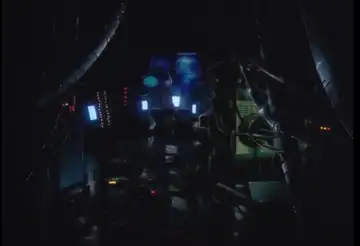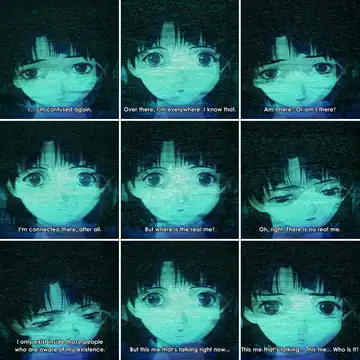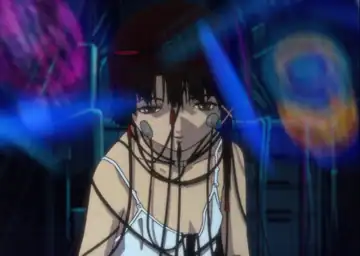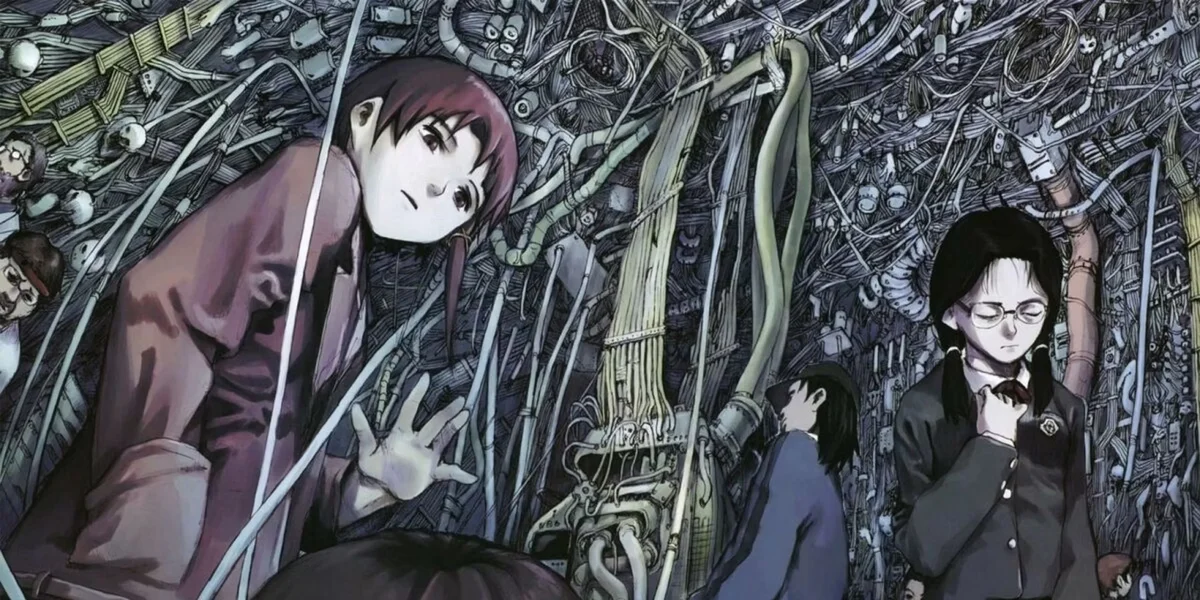Static noise, cables intertwined like veins running through an empty city. A disconnected world, where reality and virtuality blur and overlap. There, alone in her room, Lain watches. Each screen becomes a window into a space where identity fragments, and human presence dissolves. She gets lost in the Wired, where each connection seems to erode her existence a little more.
The city breathes, its cold and immense structures standing like silent witnesses to her wandering. In every corner, reality becomes fuzzy, the familiar twists under the weight of the strange. The streets, once pathways, are now endless labyrinths. Lain, a shadow in this landscape, fades away.
In Serial Experiments Lain, every thread that connects is also a noose that strangles. It is a journey toward total dissolution, where the search for identity clashes with the vastness of a hyperconnected but empty world, where each connection drives one further from oneself.
The City as a Space of Alienation and Identity Confusion
Urban Drift: Lain Lost in Her Environment

Lain moves through a profoundly hostile and alienating urban environment. The deserted streets, towering buildings, and near-total absence of human life create a setting where Lain, both observer and actor, gradually dissolves. This city isn’t just a backdrop; it acts as a visual metaphor for the loss of bearings, where Lain wanders without ever truly knowing where she’s going or who she is. The city embodies an absence of place. The emptiness and silence of these spaces create a tension between the real and the virtual, between human life and an architecture that has become oppressive, where the individual feels increasingly estranged from themselves.
In this environment, Lain is never connected to a specific place. She moves aimlessly, but these movements offer no reconciliation with herself. This phenomenon is amplified by the visual aesthetics of the series, which play with distorted perspectives, dizzying angles, and a cold color palette. These directorial choices enhance the idea of a city that gradually devours those who get lost in it, a space of total disorientation where identity dissolves.

This process of urban drifting corresponds to a central notion in psychoanalysis: the concept of Unheimlich, the uncanny. The city, though common and mundane, becomes for Lain a strange, threatening space, where the familiar turns against her and takes on an unsettling dimension. This dissociation is reflected in how Lain perceives her environment. The more she immerses herself in the Wired, the more the city loses its familiarity and becomes a territory of anxiety, a non-place where the familiar distorts.

“No matter where you go, everyone is connected.”
Freud describes the uncanny as that moment when what should be intimate and familiar becomes disturbing, even frightening. This is exactly what Lain experiences in the series: her home, her room, and even the streets she walks become spaces where she no longer fits. She has no stable frame of reference, as if the physical space itself is expelling her. This spatial dislocation represents the beginning of her identity’s disintegration, a process in which Lain no longer recognizes herself in the world around her, nor in her own reflection.
This omnipresent connection, meant to unite human beings, becomes a burden for Lain. Despite the promise of connection offered by technology, she finds herself more disconnected than ever, both from her environment and from herself.
The Wired as a Distorted Mirror of Reality

If the city represents the space of physical wandering, the Wired becomes the distorted mirror of that wandering. The Wired is as much a virtual world as a space where Lain confronts multiple and contradictory versions of herself. It is no longer a matter of place, but a question of self-perception. In the Wired, Lain is no longer one but many. She is both herself and an omnipresent entity, which fragments her identity and plunges her into a spiral of self-questioning.
The Wired is, in a sense, an extension of the city. Just as the alienating city in which she gets lost, the Wired is a space where identity is fluid, deformed, incapable of remaining intact. For Lain, entering the Wired is not merely an immersion into another world; it is a direct confrontation with psychological disintegration. She is confronted with increasingly disturbing versions of herself, constantly revealing how fragmented her self has become. This dissolution of the self echoes the psychoanalytic theories of Jacques Lacan, particularly the idea that the ego is constructed through distorted mirrors—here, the Wired becomes that mirror.

Thus, Lain is caught in a dual process of erasure. In the city, she physically loses herself, and in the Wired, she mentally disintegrates. The two spaces mirror each other, forming a cycle where the loss of bearings and identity dissolution become inevitable. What the Wired reveals is Lain’s inability to find stability in her own self, an existential crisis that culminates in her confrontation with her multiple avatars.
The Wired acts as a projection of Lain’s unconscious. In this virtual space, her fears, desires, and contradictions resurface, not as symbols, but as tangible and interactive realities. What should remain hidden or internalized in the unconscious violently externalizes in the Wired, permanently blurring the line between inner and outer, real and imaginary.
Depersonalization and Self-Dissolution
The Fragmentation of Identity

In Serial Experiments Lain, Lain undergoes a process of identity fragmentation, but this is not simply a psychological defense mechanism. The fragmentation is inherent to her very nature, given her dual existence in the real world and the Wired. Lain’s various versions of herself—shy Lain, omniscient Wired Lain, and social Lain—are expressions of this deeper, multifaceted identity. Her identity fragmentation is not merely a reaction to trauma but an essential part of her being, the result of her omnipresence in the Wired and the merging of realities.
This process is as much technological as it is psychological. Lain’s fragmented identity emerges from her very existence as an entity within the Wired, where each reflection of herself is a projection of a different part of her being. The Wired becomes a distorted mirror, forcing Lain to confront a multitude of fractured selves.
Lacan defines identity through the concept of the “mirror stage,” where the individual forms in relation to how they perceive themselves in the gaze of others. In Lain’s case, this mirror is not just distorted but entirely shattered by her dual existence. The Wired, in this sense, acts as the ultimate “distorted mirror.”

“Who are you? Who am I?”
This repeated questioning by Lain throughout the series is the ultimate expression of this loss of identity. She can no longer recognize herself, neither in the real world nor in the Wired, symbolizing a total disconnection between her internal self and the outside world.
In the Wired, Lain becomes an object of manipulation. Her reality and identity are no longer under her control; they are reconfigured by the rules of the Wired and the other entities that inhabit this digital universe. Each new interaction with this world reinforces her disorientation, leaving her unable to maintain any continuity in her identity. This gradual fragmentation can be interpreted as a reflection of the phenomenon of “psychic disintegration,” where the individual loses the coherence of their being in the face of overwhelming forces.
Depersonalization as a Consequence of Lain’s Nature

As Lain confronts these shattered versions of herself, she experiences depersonalization. However, this condition is not simply a defense mechanism. Lain’s depersonalization is a natural consequence of her existence across both the Wired and the real world. Her omnipresence in the Wired means that she is always fragmented, always existing in multiple forms. This state is less about protecting herself from trauma and more about the existential reality of her being. Lain’s inability to fully integrate these multiple selves results in a disconnection from her physical body and reality.
Lain’s depersonalization reflects the psychological and existential weight of being split between two worlds. Rather than a retreat or withdrawal due to overwhelming pressure, it is the inevitable byproduct of existing simultaneously in the Wired and reality. She is constantly shifting between these planes, and this constant movement leads to her eventual disconnection from herself and others. Her sense of self is unstable, not just because of trauma, but because her nature is inherently fluid and fragmented.

In this depersonalization, we find elements reminiscent of the symptoms of “derealization,” where the individual loses all contact with reality. Lain no longer feels the world around her as tangible. The Wired becomes her only point of reference, but even this space is unstable, fluctuating. This process leads her to complete psychic isolation.
Transcendence and Identity Annihilation
A Figure of Digital Transcendence or Self-Destruction?

The apex of Lain’s transformation occurs when she becomes an omnipresent entity in the Wired, able to transcend the limits of her physical body and manipulate reality. This passage to a quasi-divine state raises a central question: is this true transcendence, or is it actually the ultimate form of self-destruction?
Lain’s digital transcendence could be seen as a distorted version of Jung’s concept of individuation, where the individual, instead of achieving a state of higher consciousness and self-fulfillment, dissolves into a collective space where her individuality is lost. The Wired, as a space of interconnection, becomes a kind of web in which Lain’s identity dissolves, leaving behind only an omnipresent entity, empty of all humanity.

“God is here.”
This phrase, repeated throughout the series, highlights the ambiguity of Lain’s transcendence. Though she seems to reach a higher state, her humanity and individuality disappear entirely.
This process also recalls the concepts associated with the “death drive.” Faced with an existential crisis and an inability to maintain her stable identity, Lain chooses the annihilation of her self. This passage to a transcendent state is, in reality, the culmination of a death wish, where Lain, finding no place in the real world, opts for an immaterial existence, without suffering or individuality.
The Negation of Existence: An Erasure from Collective Memory
Lain’s final choice, to erase her existence from the memory of her loved ones, is the ultimate act of depersonalization. By withdrawing from collective consciousness, she denies her own past, her body, and her very existence. This choice reflects a profound disintegration of the individual, where the search for identity fails in a process of self-annihilation.

The erasure of memory is not a simple forgetfulness; it is an ontological negation. Lain ceases to exist as both a physical body and a mental entity. This complete dissolution is the logical conclusion of a fragmentation process that began with her entry into the Wired. Lain becomes an entity without a past, without identity, without a future.

“If no one remembers you, then you never existed.”
By erasing the memories of others, Lain accepts the idea that her very existence was never real. This phrase underscores the link between identity and memory, highlighting the fragility of human existence in a world where everything can be erased.
Conclusion
Through Lain’s wandering in the city and the Wired, Serial Experiments Lain highlights a process of total depersonalization. Lain progressively dissolves, losing not only her bearings in reality but also any sense of identity. Her immersion in this virtual universe exposes a psychological collapse, where every attempt to stabilize her self ends in self-destruction. The Wired becomes the mirror of her fragmented identity, a space where she confronts distorted reflections of her psyche, culminating in complete annihilation.

Ultimately, the series shows us that the quest for a stable identity, in the face of modernity and omnipresent technology, can lead to an irreversible fragmentation of the self. Lain embodies this journey toward a form of transcendence, which is nothing but a mask for the ultimate dissolution of individuality.
- yaro
